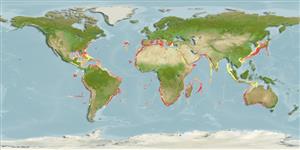>
Acropomatiformes (Oceanic basses) >
Epigonidae (Deepwater cardinalfishes)
Etymology: Epigonus: Greek, epi = over, in front + Greek, gonio = angle (Ref. 45335).
Environment: milieu / climate zone / depth range / distribution range
Ökologie
seewasser bathydemersal; tiefenbereich 130 - 830 m (Ref. 31632), usually 300 - 600 m (Ref. 4738). Deep-water; 43°N - 44°S, 98°W - 142°E
Cosmopolitan. Western Atlantic: Gulf of Mexico and Caribbean Sea. Eastern Atlantic: along the west coast of Africa to the southern tip of the continent, also western Mediterranean to southern Adriatic Sea. Indian Ocean: Reunion (Ref. 33390). Western Pacific: southwest coast of Japan, southern Australia and eastern New Zealand. Central Pacific: Hawaiian Ridge (Ref. 31632).
Size / Gewicht / Alter
Maturity: Lm ? range ? - ? cm
Max length : 20.0 cm TL Männchen/unbestimmt; (Ref. 4329)
Rückenflossenstacheln (insgesamt) : 7; Rückenflossenweichstrahlen (insgesamt) : 10; Afterflossenstacheln: 2; Afterflossenweichstrahlen: 8 - 9. Lacks opercular spines (Ref. 31632). Membranous edge at upper border of the gill cover is well developed. Caudal peduncle elongated, body not deep (Ref. 31632). Pyloric caeca 10-14. Preserved specimens are brownish to yellowish in color, dorsally darker. Numerous brown-black melanophores on scale pockets.
Adults benthic on the continental slope and collected with bottom trawls (Ref. 7321). Juveniles are pelagic in depths of 130-145 and 350-425 m (Ref. 9563). Feed on small fishes and planktonic invertebrates (Ref. 4738). Oviparous (Ref. 4738).
Life cycle and mating behavior
Geschlechtsreife | Fortpflanzung | Ablaichen | Eier | Fecundity | Larven
Maugé, L.A. and G.F. Mayer, 1990. Apogonidae. p. 714-718. In J.C. Quero, J.C. Hureau, C. Karrer, A. Post and L. Saldanha (eds.) Check-list of the fishes of the eastern tropical Atlantic (CLOFETA). JNICT, Lisbon; SEI, Paris; and UNESCO, Paris. Vol. 2. (Ref. 7321)
IUCN Rote Liste Status (Ref. 130435: Version 2024-1)
Bedrohung für Menschen
Harmless
Nutzung durch Menschen
Fischereien:
Tools
Zusatzinformationen
Download XML
Internet Quellen
Estimates based on models
Preferred temperature (Ref.
123201): 6.9 - 14.7, mean 11.3 °C (based on 479 cells).
Phylogenetic diversity index (Ref.
82804): PD
50 = 0.5000 [Uniqueness, from 0.5 = low to 2.0 = high].
Bayesian length-weight: a=0.00955 (0.00556 - 0.01641), b=3.03 (2.88 - 3.18), in cm total length, based on LWR estimates for this species & Genus-body shape (Ref.
93245).
Trophic level (Ref.
69278): 3.4 ±0.47 se; based on food items.
Widerstandsfähigkeit (Ref.
120179): mittel, Verdopplung der Population dauert 1,4 - 4,4 Jahre. (Preliminary K or Fecundity.).
Fishing Vulnerability (Ref.
59153): Low vulnerability (10 of 100).
Nutrients (Ref.
124155): Calcium = 26.5 [5.7, 102.4] mg/100g; Iron = 0.628 [0.219, 1.525] mg/100g; Protein = 2.35 [0.00, 6.08] %; Omega3 = 0.521 [0.208, 1.367] g/100g; Selenium = 10.1 [2.8, 31.7] μg/100g; VitaminA = 25.2 [5.7, 112.8] μg/100g; Zinc = 0.469 [0.238, 0.939] mg/100g (wet weight);
